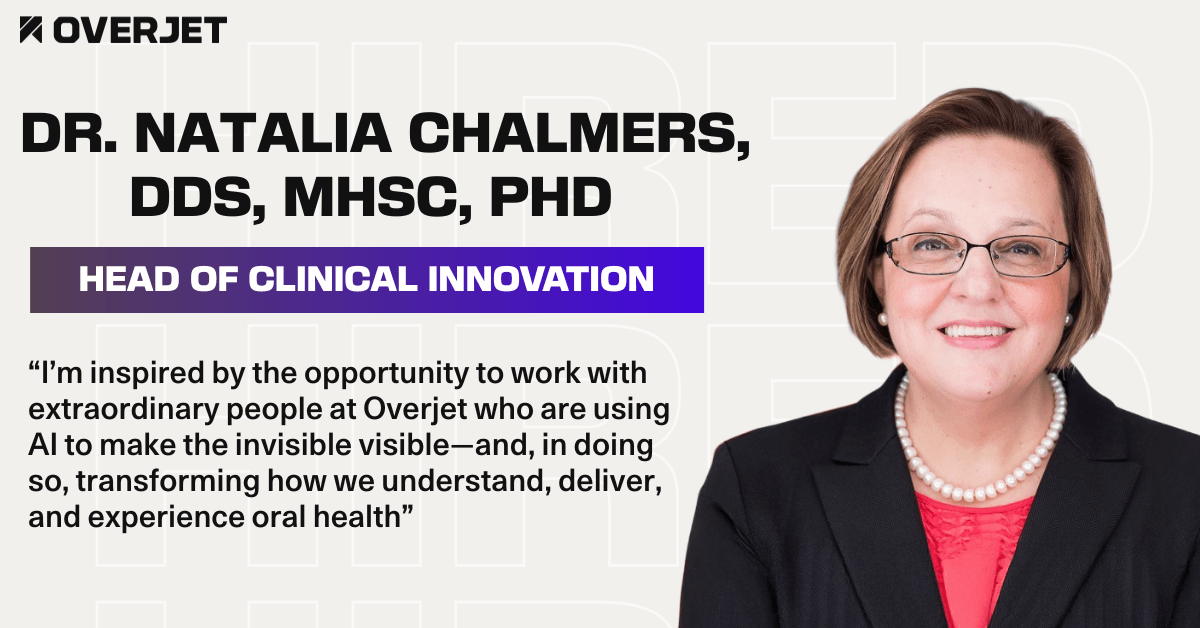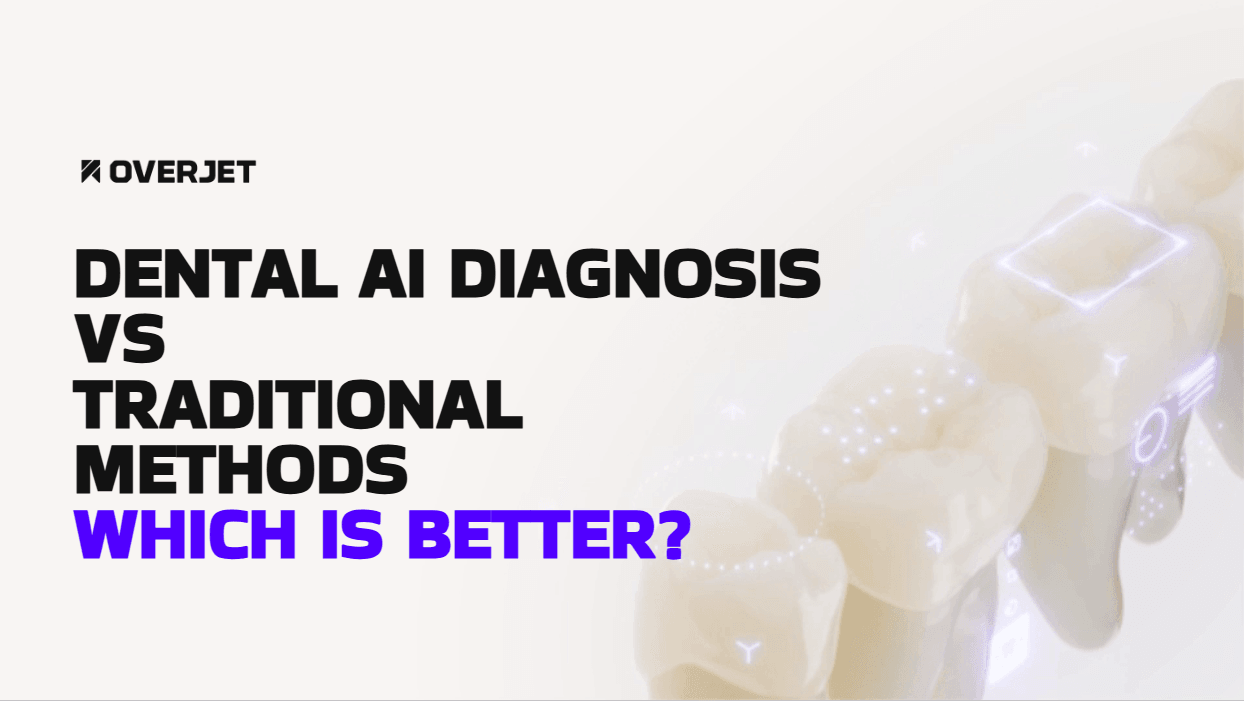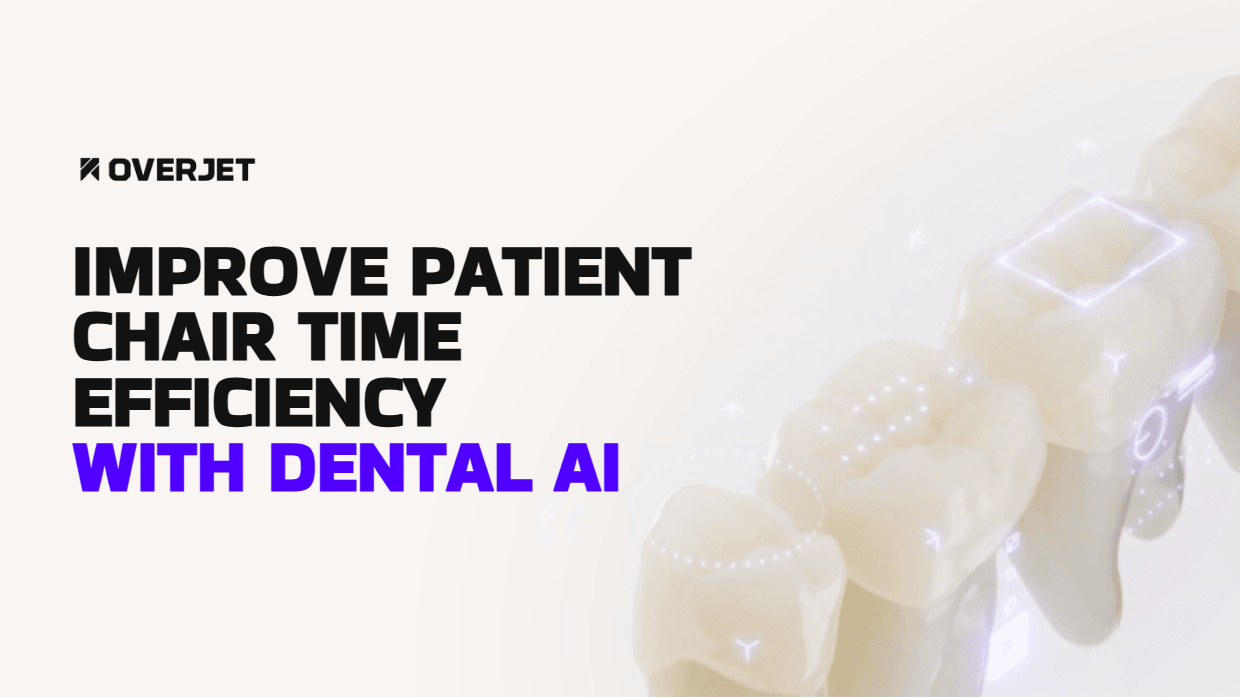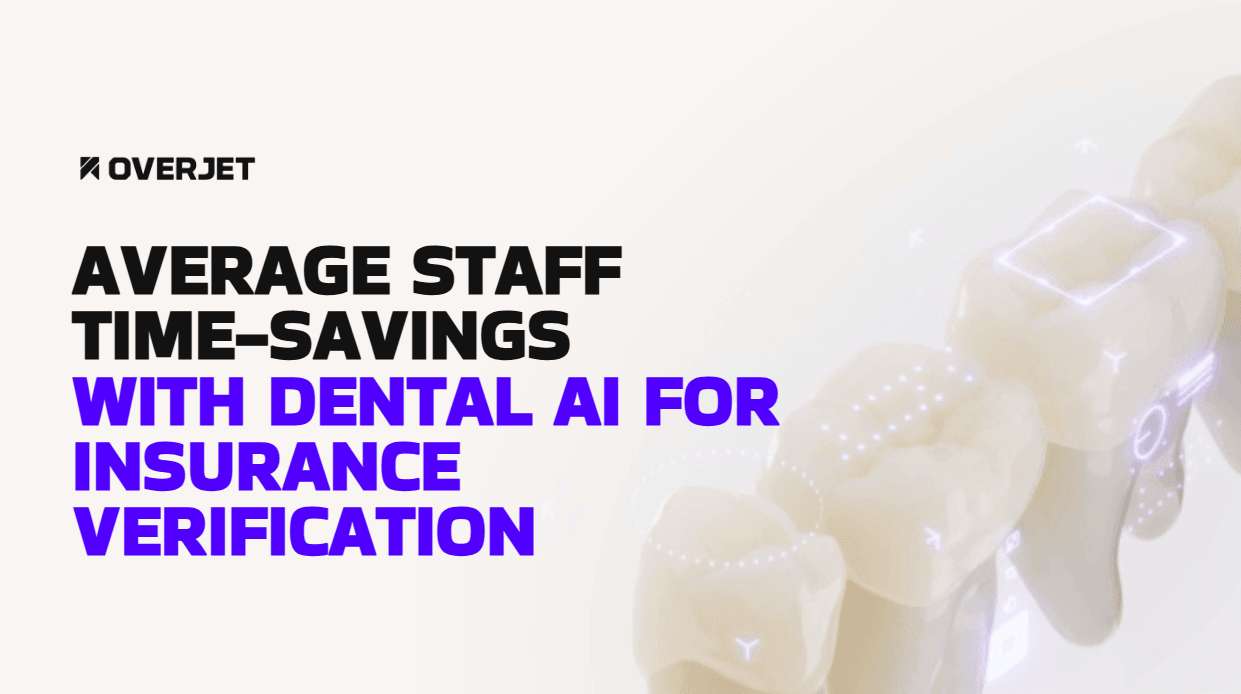Large treatment plans often stall, not because patients don’t need the care, but because they can’t visualize the problem, navigate the costs, or trust the urgency of recommendations that exceed several thousand dollars. When acceptance rates for comprehensive cases hover around 30% while routine procedures close at 80%, the gap represents both lost revenue and patients living with progressive disease.
This guide covers proven strategies that address the three primary barriers to large case acceptance: communication clarity, financial accessibility, and administrative friction. Overjet’s AI-powered platform enhances dental workflows by providing diagnostic evidence, annotated images, and streamlined insurance verification, directly supporting improved patient care and operational efficiency. You’ll learn how visual storytelling, transparent cost presentation, strategic treatment sequencing, dental treatment planning with AI, and AI-powered workflows transform hesitant patients into committed partners in their oral health.
Explore Overjet's Dental AI Software
Defining Large Treatment Plans and Acceptance Benchmarks
Large treatment plans typically start around $3,000 and can extend well beyond $10,000 for comprehensive care. These cases include full-mouth rehabilitation, extensive restorative work, or multi-phase periodontal therapy that spans several appointments. Acceptance rates naturally drop as case size increases because patients face bigger financial decisions and more complex treatment timelines.
1. Case Size Thresholds That Qualify as Large
Most practices consider treatment plans above $3,000 as large cases. Full-mouth reconstruction with multiple crowns or implants falls into this category, as does comprehensive periodontal treatment involving all four quadrants. Complex sequences that combine root canals, buildups, and crown work also qualify, especially when multiple teeth require attention.
2. Target Acceptance Rates for High-Value Care
Acceptance rates for large treatment plans generally range between 30% and 50%, compared to the 70% acceptance rate typically seen with smaller plans. Clear visual communication and flexible payment options can help bridge this gap and improve patient understanding. Overjet’s analytics can offer critical insights in this area.
Why High-Value Case Acceptance Drives Clinical and Financial Success
Comprehensive treatment acceptance supports improved patient engagement and enables practices to address oral health issues more efficiently. When patients commit to complete care plans, practices can coordinate timely interventions and deliver a higher standard of care.
Increased Lifetime Patient Value
Patients who accept large treatment plans stay with practices longer and refer more friends and family. They view the practice as their primary oral health partner rather than a place to visit only when problems arise. This loyalty translates into predictable revenue and stronger patient relationships that span years or even decades, helping boost patient lifetime value with dental AI.
Faster Disease Stabilization and Better Outcomes
Complete treatment addresses root causes rather than managing symptoms in isolation. Comprehensive restorative care eliminates infection sources and restores function, preventing the cascade of problems that comes from deferred treatment.
Patient-First Communication That Builds Immediate Trust
Case acceptance starts before you present any treatment plan. Patients accept recommendations from clinicians they trust, and that trust develops through genuine listening and straightforward explanations, which can significantly improve the dental patient experience with AI.
Active Listening Techniques During Consults
Start consultations with open-ended questions about what brought the patient in and what concerns the patient most. Repeat back what you hear to confirm understanding, this simple act shows patients their perspective matters. Acknowledging past negative experiences or financial worries creates space for honest conversation about treatment options.
Plain-Language Explanations of Diagnosis and Risk
Skip the clinical terminology and explain findings in everyday language. Instead of “generalized moderate chronic periodontitis,” try “bacteria have caused inflammation that’s destroying the bone holding your teeth in place.” Add specific timelines when possible: “Without treatment, you’ll likely lose several teeth within five years.” Concrete consequences make abstract diagnoses real and urgent.
Visual Storytelling With AI-Enhanced Radiographs
Patients accept treatment more readily when they can see the problem themselves. Overjet’s AI-powered analysis adds clear annotations to radiographs, highlighting pathology that patients would otherwise miss entirely.
Annotated Findings That Spotlight Urgency
AI-enhanced images use color-coded overlays to draw attention to specific problem areas. These visual markers help patients understand conditions they cannot detect through symptoms alone:
Bone loss: Red highlighting contrasts healthy bone levels against current attachment loss
Decay progression: Yellow annotations show how cavities extend toward the nerve
Root fractures: Enhanced contrast reveals cracks invisible without magnification
Periapical infections: Clear circles around root tips display infection spreading into surrounding bone
Overjet’s detection algorithms identify findings with high accuracy, providing objective evidence that supports clinical recommendations. When patients see annotated proof of disease progression, the need for treatment becomes self-evident rather than something they take on faith.
Chairside Tablets and Printer Handouts for Take-Home Review
Large monitors make annotated images easy to see during the appointment, but verbal explanations fade quickly from memory. Printed copies with annotations give patients something to review at home and share with family members who help make treatment decisions. These handouts often prove decisive when spouses or adult children help decide whether to proceed with expensive care.
Transparent Cost Presentation and Flexible Payment Solutions
Financial concerns block more large case acceptances than any other factor, often stemming from the rising cost of dental care. Clear upfront communication about costs paired with accessible payment options removes this barrier.
Line-Item Estimates Linked to Insurance and Out-Of-Pocket
Break down total costs by procedure code and show estimated insurance payments next to patient responsibility. This transparency prevents sticker shock and demonstrates respect for how patients plan their budgets. For multi-phase treatment, separate estimates for each phase help patients see how costs distribute over time and across insurance benefit years.
Overjet’s insurance automation provides real-time eligibility data that informs accurate estimates. Precise cost projections build more confidence than vague ranges that leave patients guessing about their actual financial commitment.
Third-Party Financing and In-House Membership Plans
Offering multiple payment options accommodates different financial situations:
CareCredit and lending partners: Extended payment terms with promotional interest-free periods for qualified applicants
Practice membership programs: Annual or monthly subscriptions offering discounted comprehensive care for uninsured patients
Phased payment schedules: Collecting payments aligned with treatment milestones rather than requiring full payment upfront
Presenting three options gives patients control over how they’ll pay. This choice increases acceptance because patients shift from deciding whether to proceed to deciding how to proceed.
Real-Time Insurance Verification and Automated Pre-Authorization
Administrative delays kill momentum in case acceptance. When patients leave without financial clarity, their motivation to proceed drops with each passing day.
Eligibility Checks Before the Consultation
Verifying insurance benefits before the clinical exam can be streamlined by AI for checking dental insurance, allowing treatment coordinators to discuss coverage during the same appointment. This immediate clarity eliminates the “we’ll call you when we hear from your insurance” delay that often results in lost cases. Patients appreciate knowing their financial commitment before they walk out the door.
Pre-Auth Packages That Cut Wait Time
Complex cases often require pre-authorization, traditionally adding weeks to the treatment timeline. Overjet’s automated claim review and pre-authorization workflows reduce wait time significantly by identifying potential denial triggers before submission and reduce dental claim denials with AI, ensuring complete documentation. Faster approvals maintain patient engagement during the critical window following diagnosis.
Sequencing Multi-Phase Therapy for Budget and Biology
Breaking large treatment plans into clinically appropriate phases makes comprehensive care more accessible while respecting biological healing requirements. Strategic sequencing maximizes insurance benefits and accommodates patient cash flow.
Prioritizing Disease Control Over Definitive Restorations
Clinical protocols dictate addressing active infection and inflammation before placing final restorations. Periodontal therapy, root canals, and cavity removal establish a stable foundation for crowns and bridges. This sequencing also creates natural financial breakpoints where patients can complete urgent phases while saving for or financing restorative work.
Phased Scheduling Aligned With Benefit Renewals
Most insurance plans provide annual maximum benefits between $1,500 and $2,500. Scheduling treatment phases to span two benefit years effectively doubles available coverage. Completing periodontal therapy in November and December, then scheduling restorative work in January and February, maximizes benefit utilization while maintaining appropriate healing intervals between phases.
Follow-Up Workflows That Convert “Maybe” to “Yes”
Patients rarely reject treatment outright, they defer decisions pending additional information, family consultation, or financial preparation. Systematic follow-up nurtures undecided cases without appearing pushy.
Personalized Text and Email Sequences
Automated yet personalized communication sequences deliver value while maintaining treatment awareness. A three-message sequence might include an educational article about the diagnosed condition, a patient testimonial video about similar treatment, and a brief check-in offering to answer questions. These messages position the practice as a helpful resource rather than a sales operation.
Scheduling Second-Look Virtual Consults
Video consultations for patients who need additional time remove barriers to re-engagement. Virtual appointments accommodate busy schedules and allow family members in different locations to participate in treatment discussions. During these sessions, you can review annotated images again, address new questions, and discuss adjusted payment options if financial concerns remain.
Tracking Acceptance KPIs Across Providers and Locations
Data-driven practices identify patterns in case acceptance that reveal both successful approaches and improvement opportunities. Consistent measurement creates accountability and guides coaching efforts.
Dashboards for Case Size, Close Rate, and Production
Track acceptance rate by case size bracket, time between diagnosis and treatment start, and conversion rate by provider. Overjet’s analytics platform aggregates clinical and operational data, revealing which providers excel at case presentation and which patients accept treatment most readily. These insights inform targeted training and process refinement.
Team Huddles and Coaching Based on Data
Weekly team meetings reviewing acceptance metrics normalize performance discussions and celebrate wins. When data shows one provider achieving 65% acceptance on large cases while others average 40%, the high performer can share specific communication approaches with colleagues. This peer coaching builds skills across the entire clinical team.
Elevate Outcomes With AI-Driven Workflows From Overjet
Overjet’s comprehensive platform directly addresses the primary barriers to large treatment plan acceptance through its verified capabilities in diagnostic evidence, annotated images, and insurance workflows. AI-powered diagnostics ensure consistent, accurate detection of pathology across all providers, while annotated imaging offers clear diagnostic evidence that supports clinical decision-making and enhances visual patient education. Automated insurance verification and pre-authorization workflows eliminate financial uncertainty and administrative delays that often derail case acceptance.
Practices implementing Overjet’s solutions report measurably higher acceptance rates for comprehensive cases, particularly when combining visual patient education with streamlined insurance processes, key factors in increasing dental case acceptance with AI.
Ready to See Overjet's Dental AI in Action?
Frequently Asked Questions (FAQs)
How do I track acceptance rates for plans that cross into a new insurance year?
Monitor each phase separately while maintaining overall case tracking in your practice management software. Link multi-year treatment sequences with a master case number that calculates blended acceptance rates across the full treatment plan. This approach provides both phase-specific data for immediate decisions and comprehensive metrics for long-term performance evaluation.
What should I say when a patient wants to consult a family member before deciding on expensive treatment?
Encourage family involvement by offering printed materials with annotated images and scheduling a follow-up appointment that accommodates the family member’s schedule. Consider saying, “Many patients find it helpful to discuss significant treatment with their spouse or adult children, I can schedule a brief consultation call where we can all review the findings together.” This approach respects their decision-making process while maintaining engagement.
How can AI technology specifically improve acceptance rates for large dental cases?
AI-enhanced imaging makes pathology visible to patients who otherwise rely solely on clinician descriptions of problems they cannot see or feel. Overjet’s automated insurance verification eliminates the uncertainty that causes patients to defer decisions, while predictive analytics identify patients most likely to accept comprehensive care based on historical patterns.
What payment options work best for treatment plans exceeding insurance maximums?
Combining insurance benefits with third-party financing creates the most accessible pathway for patients facing significant out-of-pocket costs. Offer CareCredit or similar lending options alongside practice membership discounts for the portion exceeding insurance coverage. Phasing treatment across benefit years effectively doubles available insurance dollars while spreading patient payments over an extended timeline.









